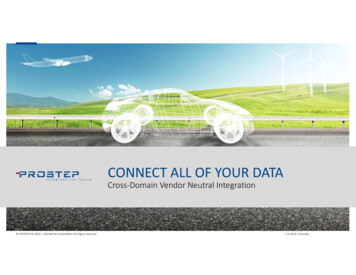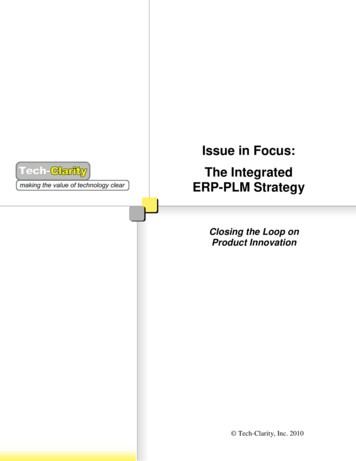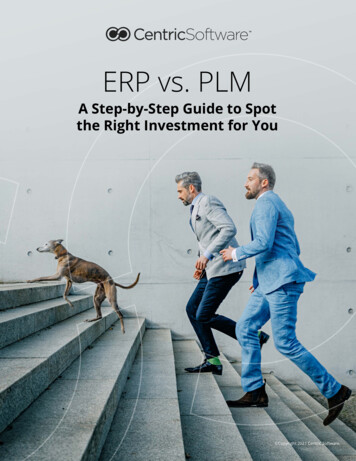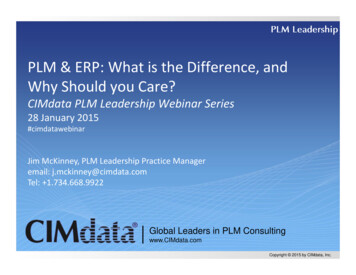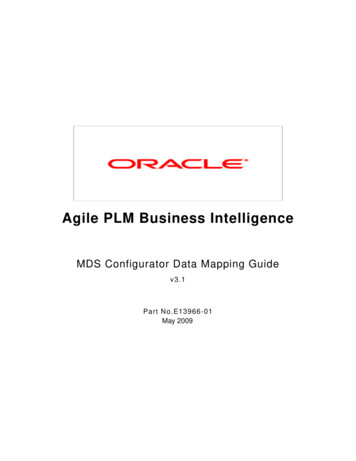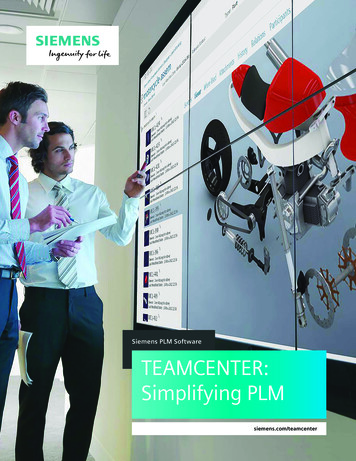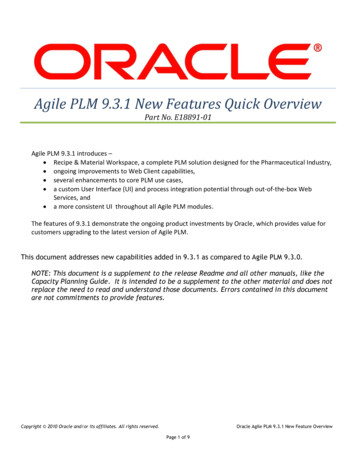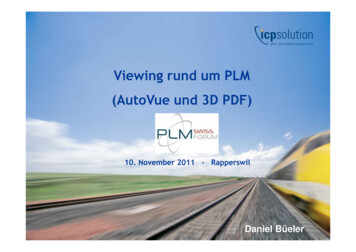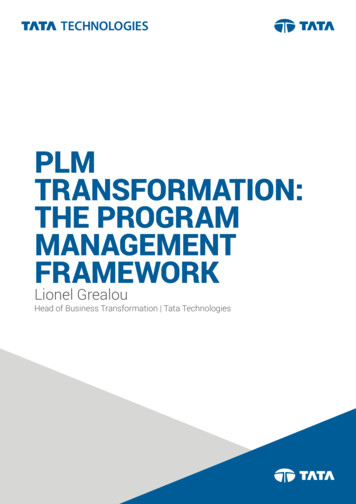
Transcription
PLMTransformation:the ProgramManagementFrameworkLionel GrealouHead of Business Transformation Tata Technologies
Enabling complex PLMprograms to realizebusiness benefitsLionel GrealouHead of Business Transformation Tata TechnologiesProduct Lifecycle Management (PLM) is a very popular strategy to deliver improved businessperformance and achieve competitive advantage. Many have embarked onto deploying a rangeof solutions to eliminate waste, reduce time to market, accelerate New Product Creation,improve collaboration, manage product and process change and open innovation. Few haveactually achieved the benefits of ‘full PLM’ because changing the business end-to-end typicallyrequires complex transformational changes which cannot be achieved in isolation. Key successcriteria include robust benefit management methodology and stakeholder governance to supportorganizational and cultural changes enabled by new processes and technology. This paperpresents a program management framework to enable successful PLM transformation initiatives –showcasing how it was implemented at Jaguar Land Rover (JLR), based in Coventry UK, to supporttheir PLM transformation journey.PLM Transformation: the Program Management Framework3
Informed Decision-MakingIn broad terms, PLM is about getting access to the right information needed to support processexecution and helping people make informed and timely decisions to carry out the lifecycle of theproduct. PLM is more about discipline, process and culture than software: ‘PLM is a discipline forguiding products and product portfolios from ideas through retirement to create the most value forbusinesses, their partners, and their customers’ (definition by Gartner).“PLM is about connecting the business to the product andenabling better informed decision-making by using a singlesource of the truth.”- John Knight-Gregson, i-PLM Program Lead, JLRPLM covers the extended Product Creation backbone. It is much more than product engineeringand product development. It goes through from design and early inception of the product toservice and disposal, and reaching to procurement, the supply base, sales and marketing andfinance (end-to-end lifecycle).PLM TransformationMost PLM implementations are typically reported as being IT-driven initiatives focusing ontraditional deployment challenges: 1) selecting the right PLM toolset, 2) implementing the requiredbusiness rules, and 3) defining phase-wise deployment for minimal disruption of the productionoperations.While the above can be considered as minimum requirements to deliver any PLM projects orprograms, they may not be sufficient to deliver upon the ‘full PLM’ promise. Individual PLMinitiatives might contribute to series of relevant business improvements and levels of integration,however, their cumulative benefits might not be anywhere near the initial expected end-to-endresult. Notwithstanding the fact that it might take years of implementation and deployment effortsbefore this conclusion can be drawn.‘Full PLM’ benefits can be achieved through a business transformation approach as opposed toa tool replacement approach. This is why the focus of any PLM initiative which aims at making adifference should be on delivering critical business objectives and improvements that support thePLM vision. Transformational changes imply: Defining process improvements that constitute fundamental changes to the way the businesscurrently operates (with agreed high level business requirements that carry clear recoverablebenefit in dollar value). Aligning changes related to people, process and technology more closely with its businessstrategy and PLM vision (with a holistic view to meeting long term objectives).This can be driven by focusing on making significant improvements to customer service levels and4PLM Transformation: the Program Management Framework
enhanced customer experiences, by reviewing and the appraisal of what a business should do, byworking with partners and by making better use of all types of resources, by improving the way thebusiness works, and embracing new organizational structures, skills, processes and technologies.Business Benefit-Driven‘Full PLM’ transformation is about aligning PLM vision and strategy with business requirementsfrom Product Creation, Manufacturing, Marketing and Sales, Finance and HR functions, in aholistic and integrated manner. This is to drive benefits across all functional areas and includeresource efficiencies, Research & Development cost savings, supplier cost savings, material costsavings, reduced assembly hours per vehicle, serviceability efficiency, etc.Typical measurable business benefits from PLM transformation initiatives include a wide range ofbusiness improvements, such as: Using a single Bill of Material (BOM) approach that represents a ‘single source of the truth’ sothat master data is created once and consistently used many times (eliminating waste – e.g.multi-BOM synchronization and various related inefficiencies); this should enable engineers tofocus on designing new products, rather than spend valuable time maintaining BOMs. Using product visualization capability to review key ‘building data’ attributes, such as cost,weight, material, special relationships, both static and dynamic, etc. and reconnect themanagement to making decision with the product in sight (rather than looking at spreadsheetsin isolation); this assumes accessing the right information at the right time through sharedknowledge resources supported by a well-integrated and holistic Building Information Model(BIM) – e.g. to enable manufacturing tooling change cost impact analysis while making designchange proposals. Accessing visualization data and relevant PLM dashboards from mobile devices to connect theteams back to the product – e.g. visualizing material, weight, cost or other ERP attributes ontothe product Digital Mock-Up (DMU) on portable devices with light and accessible data. Integrating the extended enterprise into using common processes, including offshore / lowcost delivery centers, suppliers and partners (e.g. Joint Ventures), and supporting ProductCreation growth globally (operational scalability). Enabling effective management of product data includes the entire value chain – the entiretyof all the processes, both inside and outside the company, touching product data from at anyand every stage of the product lifecycle. Enabling seamless PLM-ERP integration – e.g. to allow new parts in PLM to be published toERP, configuration engine supporting for PLM and ERP critical processes, or cost managementdriven from ERP to be reflected into PLM. Supporting increasing product business requirements, including electronic software system Prioritizing business improvements based on expected recoverable benefits across the entireand system engineering requirements which are growing fast.product lifecycle – while removing hidden factories (non-value-added activities hided orPLM Transformation: the Program Management Framework5
embedded in any process operation) in organizations, reducing the number and complexity ofinterfaces, and simplifying the supporting IT landscape and architecture. Managing PLM deployment in waves – of various sizes and duration depending on thebusiness case which need to encompass for business and cultural readiness, business growthpriorities and pain points.Organizational and Cultural ChangesPLM as a business transformation will obviously be IT-enabled, but people related issues are likelyto constitute the most significant challenge in implementing and deploying the solution. It willpotentially require significant cultural changes which will be enabled by various factors: Finding compromises in defining new processes to avoid ‘reinventing the wheel’ or heavily Defining new organizational structures to support new processes and new ways of working. Implementing robust risk management approaches to support complex PLM deployment andcustomizing the tool to match users’ expectations.mitigate any resistance to changes (e.g. redundant roles following process improvements,transition to using better working processes while delivering existing products which will be atvarious stages of their lifecycle). Aligning HR policies to support business operations related to new PLM processes.Typical business transformation initiatives imply implementing positive disruptive changes torealize ‘full PLM’ benefits – ‘disruptive’ in terms of being a major step-change or a more radicalgame changing opportunity; and ‘positive’ in terms of being better than previously.Integrated people and process considerations as well as data model dependencies are critical todrive these changes. It is also necessary to assess transition disruption from legacy landscape tonew solution and derive a transition strategy that the business can buy into. The deployment planshould not solely follow an Information Technology (IT) system implementation decision-drivenapproach, but a business-driven one that can encompass for complex changes to be deployedwith minimal and controlled operational disruption. Temporary technical bridges are sometimesrequired to support the transition period.PLM solutions must take into consideration software integration and evolution capabilities. Itis also important to note that PLM initiatives are not software development but deploymentprojects. From an IT implementation perspective, PLM solutions should be based on out-of-thebox vendor software that is configured to be fit for purpose, with minimal and controlled levels ofcustomization with possible temporary interfaces to legacy environments to support the transitionperiod. Choosing which interfaces to keep long term is to be carefully considered to reduce costof ownership. Applying these principles and using a robust benefit-driven control frameworkto monitor PLM implementation sometimes constitute a cultural and mindset shift for the ITdepartments responsible for the technical build.6PLM Transformation: the Program Management Framework
Program Management FrameworkEffective PLM business transformation initiatives are typically structured in programs followinga multi-wave implementation and deployment framework. Managing PLM transformationinitiatives as programs allows focusing on benefit realization and aligning consistently complexinterdependent projects to deliver against a common set of objectives and vision. A program iscommonly defined as a group of related projects managed together to obtain specific businessbenefits and controls that would likely not occur if these projects were managed individually.Program management is focused on achieving the strategic objectives and benefits of a number ofintegrated PLM projects. An effective Program Office framework “Accelerate-PLM” was specificallycreated to support PLM transformation programs which require robust attention to benefitrealization and governance. This framework is based on 15 core pillars as described below.1. Stakeholder managementKey customers and other stakeholders must be clearly identified – e.g. from c-level executivesto business champions, current functional process owners, Subject Matter Experts (SMEs) andtechnical experts. Stakeholder mapping is necessary to identify influencers, supporters, levelof interest and power in the organization at various levels and roles. This will need constantmonitoring and will derive into concrete actions to align and communicate to the businesscommunity, across various business functions, internally and externally.Stakeholder management plays a critical role in delivering successful PLM programs, from apeople and process point of view. PLM programs are typically aligned to address specific critical‘pain points’ in the business. The delivery structure of the program is organized in business-drivenworkstreams which constitute a matrix structure across PLM technical domains.2. GovernanceRobust governance is a critical success factor to implementing changes, especially in complex PLMprograms – however, it is consider as ‘best practice’ to implement a strong governance structure tosupport any business transformation initiatives to ensure people and process alignment. A typicalPLM governance structure includes the following key forums: Strategic executive steering committee, which regroups the ultimate program sponsors at the Program board, which focuses on strategic decisions related to the PLM program. Change Advisory Board (CAB), which sanctions the change control process overall. Business Change Authority (BCA), which is to capture business requirements, coordinateapex of the business to align strategic goals inter and intra-programs.process definition activities, identify organizational impacts, define new ways of working, andfocus on benefit realization; the BCA also typically owns the communication and deploymentstrategy.PLM Transformation: the Program Management Framework7
Solution Definition Authority (SDA), which focuses on the technical solution ‘fit for purpose’; Business workstream champion and team forums, which focus on both change managementthe SDA owns the transition strategy.and delivery following a matrix structure across business change and technical teams.The program governance model is contextually based in any organization and is to be adjusted tovarious cultural factors and the change vision that supports the PLM program.3. Requirement managementBusiness requirements must come from the business. Significant effort is typically required todefined and document them consistently. They are based on high level assumptions that mustbe shared and validated across the business. Various dependencies might also emerge fromthese assumptions and business requirements. They then cascade into detailed functional andnon-functional requirements that will need to be translated into design specifications and testedaccordingly in a structured manner (typical V-system approach).Business requirements must be attached to specific projects or groups of projects forimplementation.4. Scope managementThe high level business case of the PLM program constitutes the high level scope at inception.Business requirements and benefit rationalization are then to drive the scope of the program (topdown analysis at start-up and bottom-up analysis at initiation). The core of the solution, or ‘PLMbackbone’, is typically technology dependent and constitutes the foundation of the new technicalarchitecture.Every business requirement and their expected benefits constitute the scope the PLM programwhich derives into its respective sub-projects for implementation. Quick-win projects might beidentified to demonstrate early adoption by the business and facilitate business transformationpreparation. These projects are also to be managed holistically in terms of scope to avoid anydeviation from the overarching strategic intent.5. PlanningProgram and project-level plan cascade (milestone) and roll up (progress) into each other in astructured approach. A typical planning framework includes: Level 0 program plan (or roadmap) – with high level timing, phases and gates across single or Level 1 program plan – with high level tasks and workstream milestones which govern amultiple delivery waves.specific delivery wave, including high level intra and inter-dependencies (across strategicprojects and programs – e.g. PLM and ERP program dependencies).8PLM Transformation: the Program Management Framework
Level 2 program plan – with detailed deliverable tracking activities and millstones, showing Level 3 project plans – with detailed resourced activities, dependencies, and deliverablesdetailed dependencies and overall critical path across sub-project portfolio.which align to the level 2 program plan.Program planning includes: Weekly planning cycle Key delivery and communication milestones Core resource pool management Project interdependency and critical path monitoring Planning standards and templates Program gateway artifact readiness and countdown process.6. CSF-KPIConcise and regular reporting is critical to delivering successful PLM projects. Dashboards must becreated to enable informed decision-making and effective communication. This will also be criticalto sustain executive engagement on the program.Defining the right metrics and reporting cadence and format must be linked to the programgovernance and structure. Clear metrics are defined against each KPIs and CSFs and monitoredweekly or monthly: Critical Success Factors (CSFs) – which define success. Key Performance Indicators (KPIs) – which define how to measure success for each CSF.7. Benefit realizationTop-down benefit estimation is typically done at program inception, in a top-down manner forbudget preparation purposes. Then, benefits are assessed in more detailed during the programinitiation. Bottom-up benefit analysis is done for all individual projects and at the program levelwhile rolling up all sub-project benefits in a bottom-up manner.It is mandatory to monitor expected benefit realization by workstream on an ongoing basis, andfollowing the change control process. Program benefit and scope are closely related; a robust riskand issue management is required to control and manage stakeholder expectations as the programmatures. Benefit change impact assessment is an integrated component of the change controlprocess.PLM Transformation: the Program Management Framework9
8. Budget / costIt is expected that, for strategic PLM initiatives, budget will be granted for delivery of a specificprogram wave rather than on a project-by-project basis. As the matter of fact, this will be the mostefficient way to ensure that the PLM transformation is led by benefit realization rather than solelytechnology change.On a typical PLM program, cost will be managed at sub-project and program levels, across thelifecycle of a specific wave and also on an annual basis (for year on year budgeting trackingpurposes).9. Change controlEvery projects and programs require a Change Request (CR) process to manage changes in scope(deliverables), benefit, cost, and delivery timings – components which are obviously closelyinterrelated.Changes are to be assessed for ‘fit for purpose’ by both BCA and SDA, and then ratified by theprogram CAB, such as: Is this change aligned with the program strategy? Is additional information required? (e.g. damage statement / impact analysis) Are all CAB stakeholders supporting the CR? Have impacts on business requirement been identified? Have impacts on other technical domain and project dependencies been analyzed? Have cost and benefit impacts been identified? Have impacts on the program plan been identified? Has a plan or specific action been agreed for the CR to be implemented?10. Supplier managementSpecific suppliers / partners might be identified to support PLM transformation programs and helpwith risk mitigation and quality assurance. Contract and relationship management is at the core ofsuccessful delivery of complex and/or large PLM initiatives. This typically implies Memorandumof Understanding, Master Services Agreement, Statement of Work, and other contractualarrangements to support delivery services. For System Integrator (SI) suppliers, detailed ServiceLevel Agreements must be defined and managed throughout the execution of each programphases. The management and coordination of specific skills and resources is typically monitoredas the program matures to ensure continuity of service, knowledge transfer and support as thesolution get deployed and handed over to Business as Usual (BaU) functions.10PLM Transformation: the Program Management Framework
11. Methodology and artifact managementProgram artifacts must be consistently defined and managed. Effective communication andpositive leadership of the management team is critical to keep sight of the program vision androadmap. Middle management leadership is also critical to cascade the information downstream tothe delivery teams.A program artifact library must be created to ensure that templates, methodology documentationand PLM deliverables are consistently and efficiently captured, and stored centrally in a commonand accessible repository – e.g. typically stored on structured SharePoint sites.Various methodologies are required to deliver effectively and efficiently, such as: PLM technical functional and non-functional requirement documentation templates Assessment and monitoring tools Benefit trackers Process forms, lists and templates Process mapping templates and tools User Acceptance Testing (UAT) methodology On/off-shore delivery and ‘software factory’ framework Web site templates Etc.(blueprint)12. Resources and facilitiesEfficient resource ramp-up is critical to enable complex program delivery. Recruitment and on/offboarding processes are to support this ramp-up, manage the different enabling assets, and ensurethat new team members are quickly integrated, knowledge from leavers is transferred to the teamsand each program resource is able to deliver as per expectations. The implementation of theseprocesses depends on the supplier engagement model and team location.13. Assurance and learningOn complex PLM initiatives, quality assurance is a key component to get internal and externalfeedback. These might be in the form of: Regular program health-checks Quality standards, checks and balances Risk assessment and mitigation / roll-back plansPLM Transformation: the Program Management Framework11
Knowledge sharing database and collaboration / learning tools14. CommunicationBusiness transformation initiatives require a robust communication strategy to encompassfor the various stakeholders’ expectations. It is meant to facilitate cultural changes and theimplementation of new processes.The communication strategy articulates, explains and promotes a vision and a set of well-definedgoals; it creates a consistent, unified “voice” that links diverse activities and goals in a way thatappeals to a specific stakeholders. Various activities will derive from the communication strategyand will be managed as part of the communication plan. It typically includes: Stakeholder mapping-driven and audience-centered communication, including riskmanagement and in a constructive way that follows the program governance structure. Communication processes for business requirement gathering, adoption, validation, sign-offand benefit realization. Business impact assessment (internal and external communication). Event sequence, template and planning for requirement delivery review with businessstakeholders (at various levels – e.g. champion, key users and SMEs, etc.). Early adoption and deployment messages. Education or change agents and ramp-up to entire business communities. Cultural change measurement. Organizational change and risk assessment. Clear, concise, consistent, convincing and compelling PLM transformation branding.Various media and approaches are to be used as part of the communication plan to implement therequired strategy; in no particular order: various events, from Share Fair to surveys, internal andinternal web sites, videos, use cases, process workflows, mobile dashboards, newsletters, etc.Risk and issue managementThe consistent, systematic and continuous management of risks and issues is critical for thesuccessful delivery of any business initiatives. It is even more relevant for complex PLM programswith various dependencies and which involve number of stakeholders across many businessfunction. They need to be managed centrally and follow clear monitoring and escalation processeswith touch points at different levels in the program governance structure. Typical managementof mitigation and resolution plans are in place to deliver deployment activities and organizationalchanges.12PLM Transformation: the Program Management Framework
Lessons Learned from the i-PLM Program atJLRThis Program Management framework was implemented at JLR to support their PLM businesstransformation journey.“Tata Technologies was instrumental in defining anddelivering the i-PLM Program Office which plays a criticalrole as part of the program management team.”- John Knight-Gregson, i-PLM Program Lead, JLRRobust governance and adherence to terms of reference has proven to be critical in cascading andescalating consistent communication and making informed decisions at various levels on a programof this complexity and size.Tangible benefits from implementing this program management framework to the i-PLM programat JLR include: Controlled and stabilized business requirement and scope for wave 1. Visibility of senior stakeholder engagement and ability to address issues in a timely manner. Cultural shift from issue to risk management initiated (implying a more robust forwardplanning approach). Robust program planning methodology and change control processes. Capturing of lessons learned from wave 1 to define improvements to be made to futureprogram waves. Smooth passing of program ‘Planning and Consolidation’ gateway for wave 1 in July 2012.PricewaterhouseCoopers (PwC), which was appointed as program assurance partner for i-PLM,also noted in their health-check report that:“Overall, we view the i-PLM program as being very wellled and managed, following a sound execution strategy inline with the best performing programs we review acrosssectors. There are examples of best-in-class programmanagement practices in a number of areas ( )”- Stephen Baker, Director, PwC (extract from i-PLM Program health-check, second report, July 2012)PLM Transformation: the Program Management Framework13
SummaryThis paper demonstrates that addressing cultural problems may be as important, or moreimportant, than technical solutions when implementing a new PLM solution; this actually appliesto any PLM initiatives, but is even more relevant when implementing complex (and often large)PLM business transformation projects or programs. Realizing the potential of the PLM promiseimplies aiming at a clear and robust long term PLM vision that might include the implementation ofdisruptive changes.14PLM Transformation: the Program Management Framework
Tata Technologies makes product development dreams become a realityby designing, engineering and validating the products of tomorrow forthe world’s leading manufacturers.Our clients are under increasing pressure to create more products, faster than before,and better than ever to stay competitive. For more than 20 years, we have empoweredthem with the tools, technology, and processes to meet and exceed market demands.
ABOUT TATA TECHNOLOGIESTata Technologies, founded in 1989, enables ambitious manufacturing companies to design and build better productsthrough engineering services outsourcing and the application of information technology to product development andmanufacturing enterprise processes.With more than 7,900 professionals, Tata Technologies focuses on the manufacturing industry – covering every aspectof the value chain from conceptualization and manufacturing to aftermarket and maintenance repair overhaul support.Tata Technologies supports clients through engineering services outsourcing, product development, enterprise ITservices and product lifecycle management solutions.engagements that offers a unique blend of deep, local expertise integrated with 17 global delivery centers acrosswww.tatatechnologies.com. 320M USD7,900 CONSOLIDATED PROFESSIONALSREVENUETHE COMPANYWE KEEP7,900 EmployeesRepresenting 28 nationalities/TataTechnologiesAEROSPACEOEMS3 MACHINERYOEMS17 Global Delivery CentersAPAC, EU, NAUSA – Troy, Detroit and others Europe – Warwick (UK),Gothenburg (Sweden), Brasov, Craiova & Iasi (Romania),Gaimersheim (Germany) and others India - New Delhi, BlueRidge & Hinjawadi - Pune, Bengaluru, Thane and others China Shanghai (China) SEA - Tokyo (Japan), Bangkok (Thailand),Singapore, Vietnam (Hanoi)/TataTechnologies/TataTech News/TataTechnologiesASIA PACIFICEUROPE25 Rajiv Gandhi Infotech ParkThe European Innovation andNORTH AMERICA6001Cass Avenue,Hinjawadi, PuneDevelopment Centre (EIDC)Suite 600, Detroit MIIndiaOlympus AvenueUSA411057Tachbrook Park, Warwick, UK48202CV34 6RJTel. 1 248 426 1482Tel. 91 20 6652 9090Tel. 44 (0) 8443 759685
Enabling seamless PLM-ERP integration - e.g. to allow new parts in PLM to be published to ERP, configuration engine supporting for PLM and ERP critical processes, or cost management driven from ERP to be reflected into PLM. Supporting increasing product business requirements, including electronic software system
